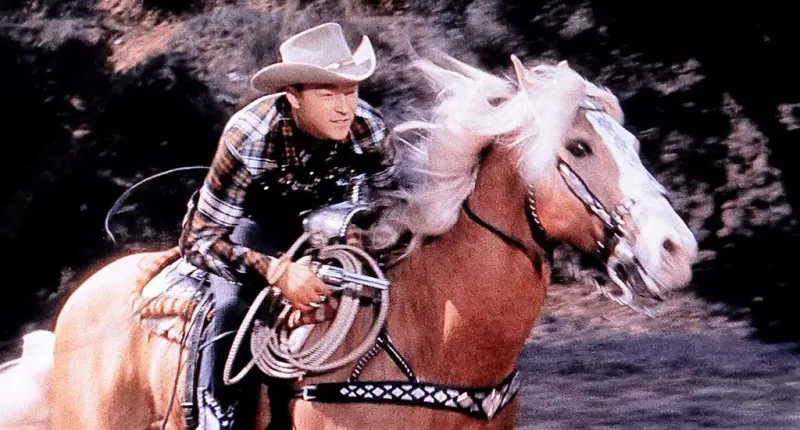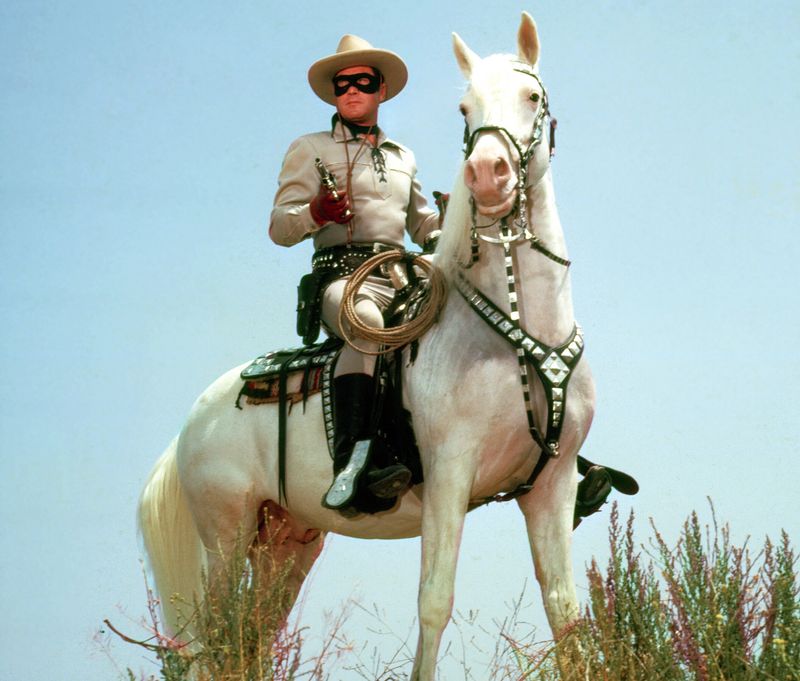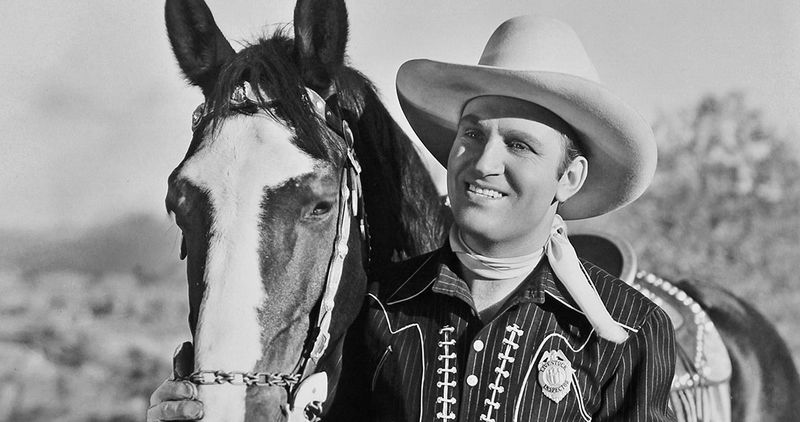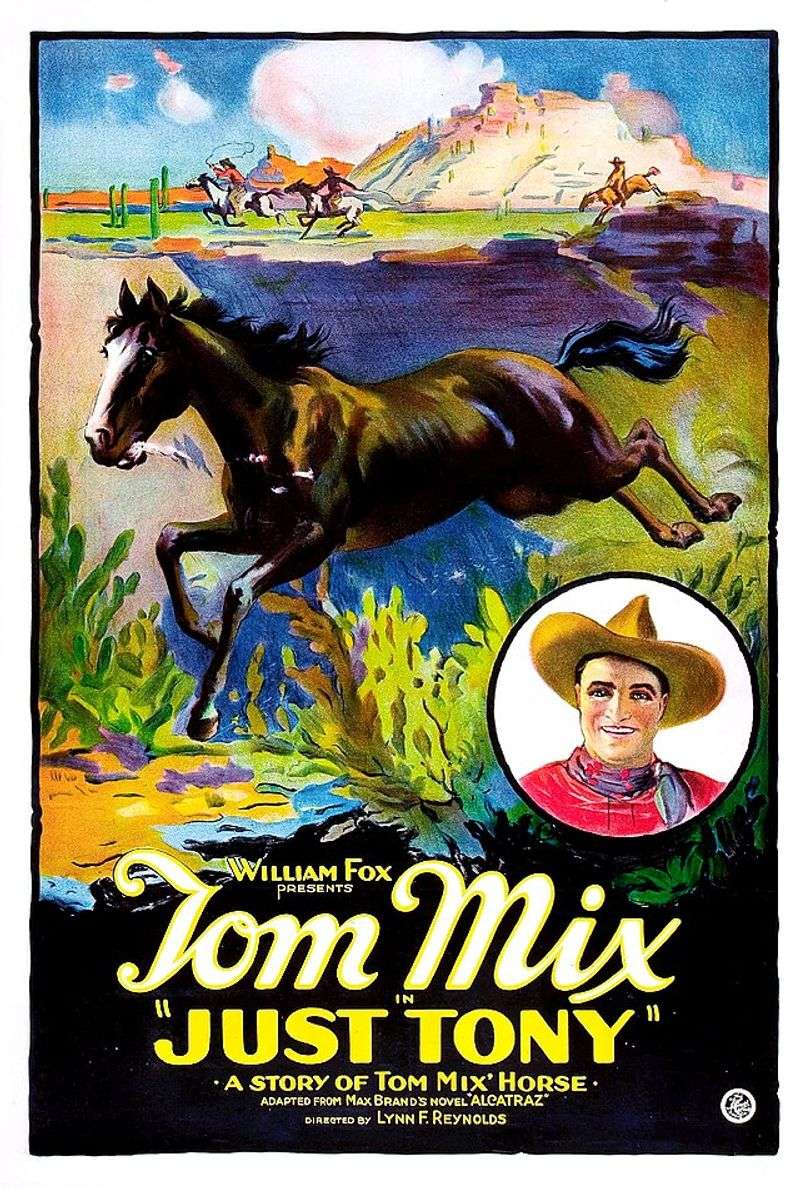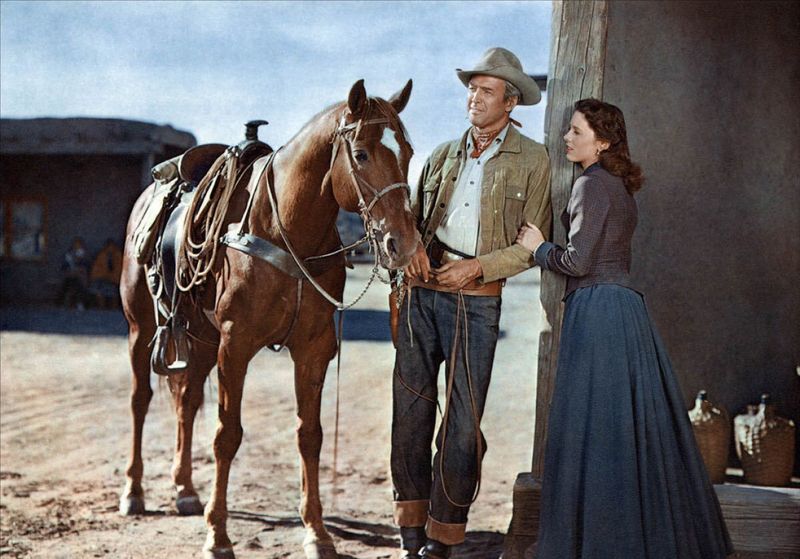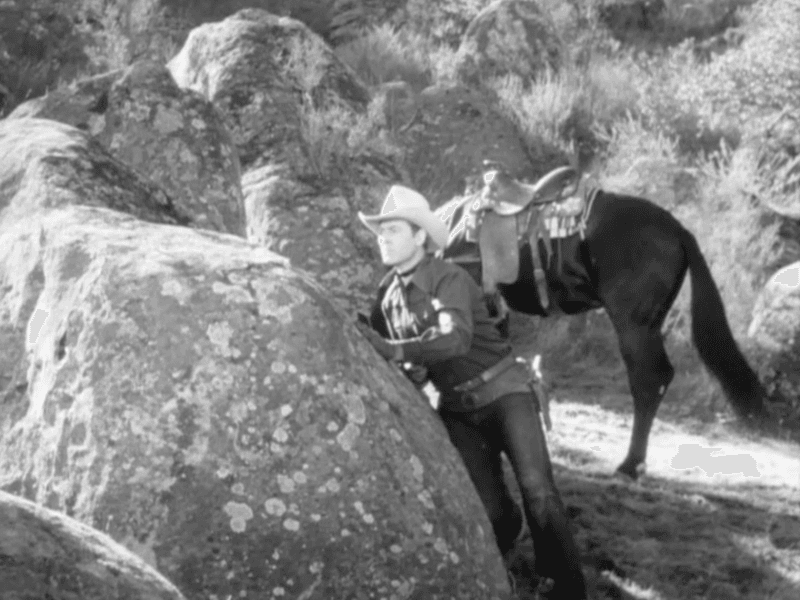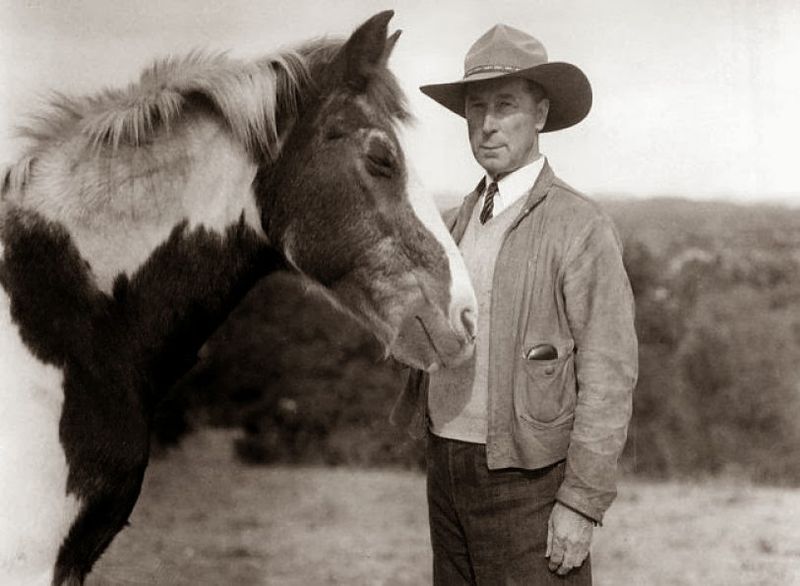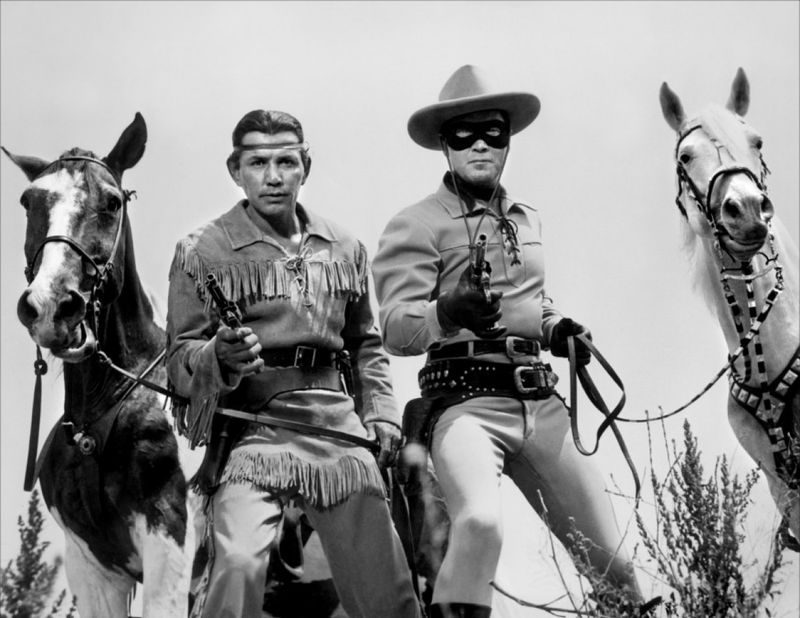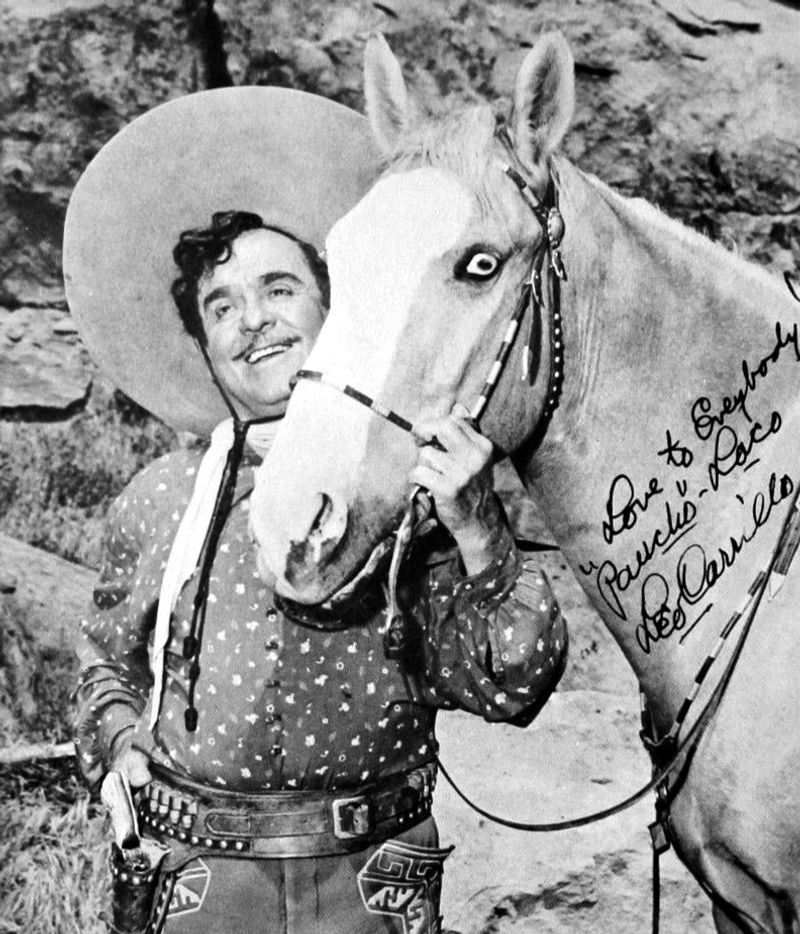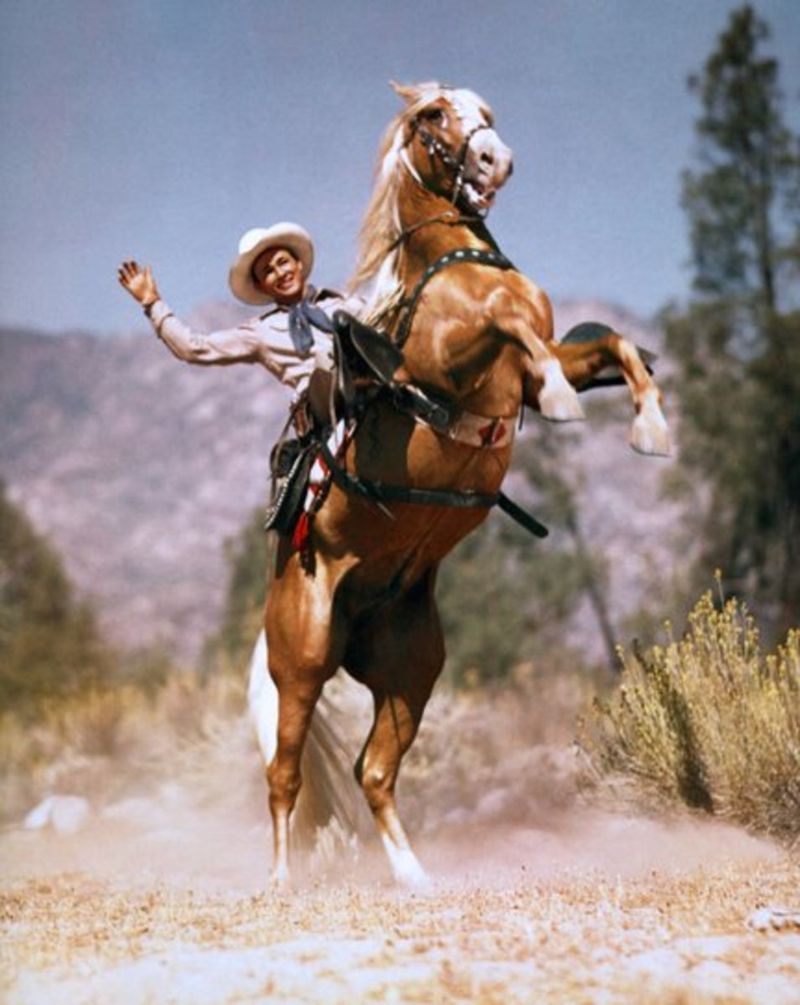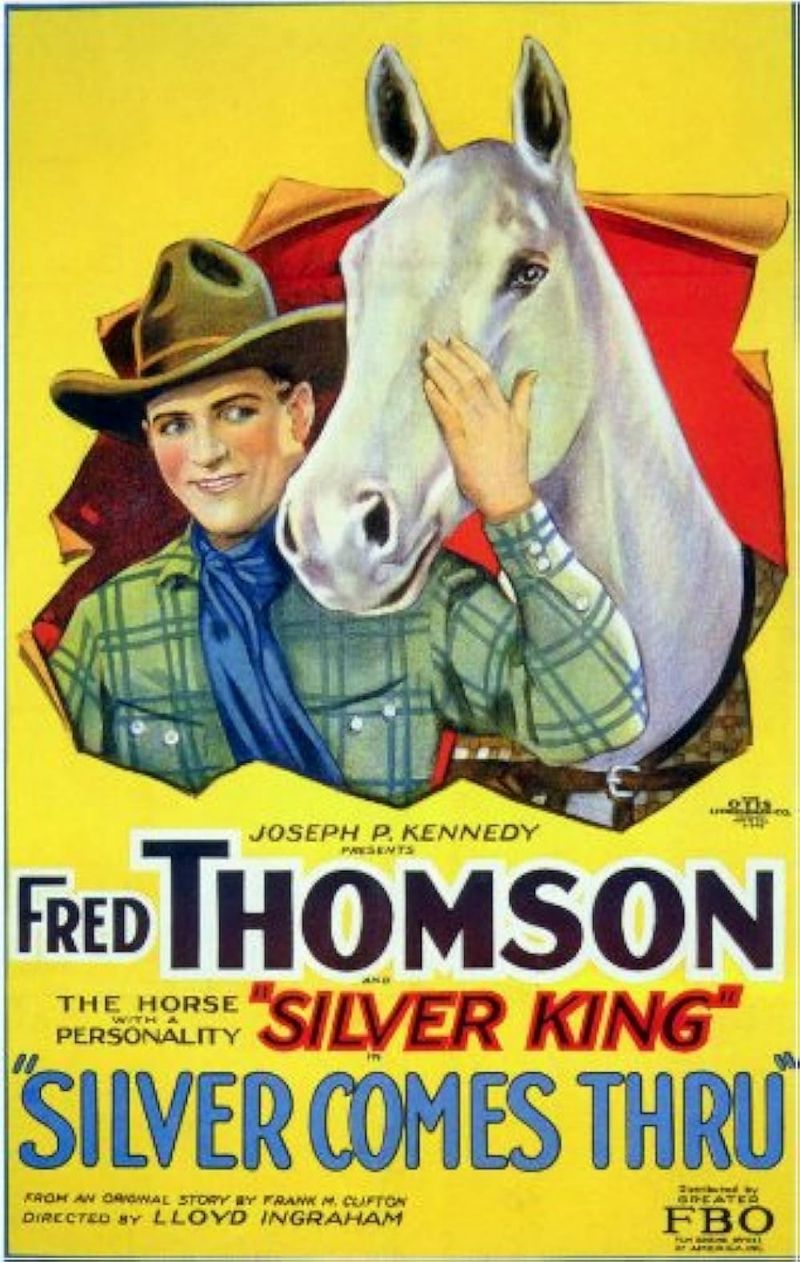Western films captured the hearts of Americans with more than just gunfights and saloon brawls. The real magic happened when a cowboy hero and his trusted horse galloped across the screen together. These four-legged stars weren’t just transportation – they were full-fledged characters with personalities all their own. While Trigger and Silver might still ring a bell, many magnificent horses who once captivated audiences have faded from memory.
1. Trigger & Roy Rogers
Golden-coated and impossibly intelligent, Trigger earned his nickname “The Smartest Horse in the Movies” by mastering over 100 tricks and responding to subtle cues from Roy Rogers. The palomino stallion could untie knots, sign autographs with a rubber stamp, and even count by stamping his hoof.
Rogers purchased Trigger for $2,500 in 1938, a decision that created perhaps the most iconic cowboy-horse partnership in Hollywood history. They appeared together in 88 movies and 100+ TV episodes.
Unlike most animal actors, Trigger was never replaced; the same magnificent horse performed for 20 years until retirement. When he died in 1965, Rogers couldn’t bear to bury his beloved companion and had him preserved through taxidermy.
2. Silver & The Lone Ranger
Thundering hooves and a dramatic whinny announced Silver’s arrival long before “Hi-yo Silver, away!” became America’s favorite catchphrase. This magnificent white stallion wasn’t just transportation for the masked hero—he was a character with his own origin story.
According to legend, the Lone Ranger rescued Silver from a wild buffalo attack, nursed him back to health, and earned his undying loyalty. The horse’s intelligence rivaled human reasoning in many episodes, as he untied ropes, distracted villains, and even fetched help when needed.
Three different horses portrayed Silver throughout the television series, but audiences never noticed the switch—each embodied the same spirit of freedom and justice.
3. Champion & Gene Autry
Billed as “The Wonder Horse” in movie credits, Champion wasn’t just Gene Autry’s sidekick—he was a bona fide celebrity with his own fan club. This chestnut stallion with four white stockings performed mathematical calculations by tapping his hoof and could seemingly understand human speech.
Champion’s fame reached such heights that he starred in his own CBS television series, “The Adventures of Champion,” which ran from 1955 to 1956. Autry actually owned several horses named Champion throughout his career, but maintained the illusion they were all the same remarkable animal.
At public appearances, children would line up to meet Champion rather than Autry himself. The horse even had his own comic book series and personalized merchandise.
4. Buttermilk & Dale Evans
While the cowboys got their stallions, Dale Evans rode sidesaddle on Buttermilk, a buckskin Quarter Horse with a distinctive black mane and tail. Don’t be fooled by the sweet name—this horse had spirit and athleticism that matched any of her male counterparts on screen.
Evans initially struggled to connect with Buttermilk, who had a stubborn streak. Their eventual bond became so strong that Evans refused to ride any other horse on set.
Buttermilk’s calm demeanor during chaotic filming conditions made her invaluable. When pyrotechnics exploded or gunshots rang out, she remained steady, allowing Evans to perform her own riding stunts without fear. Their partnership lasted 15 years, appearing in 28 films and over 100 TV episodes.
5. Tony & Tom Mix
Long before CGI, Tony the Wonder Horse performed death-defying stunts that left audiences gasping. This brown-and-white pinto could leap across chasms, dive from cliffs into water, and gallop through burning buildings alongside silent film star Tom Mix.
Tony earned a salary of $75 per week in the 1920s—more than many human actors of the era! His name appeared in giant letters on movie posters, sometimes larger than Mix’s own billing.
Mix and Tony’s partnership changed western filmmaking forever by establishing the heroic horse as essential to the genre. When they traveled for publicity tours, Tony stayed in hotel rooms rather than stables and had his own custom-made railroad car. The duo appeared in over 180 films together, many of which showcased Tony’s remarkable jumping ability.
6. Pie & James Stewart
Unlike flashy show horses, Pie was a no-nonsense chestnut gelding with a plain face and workmanlike attitude—much like his famous rider, James Stewart. Their partnership began with the 1950 film “Winchester ’73” and continued through 17 westerns, creating one of Hollywood’s longest-running human-equine collaborations.
Stewart became so attached to Pie that he requested the horse for every western he filmed. When other actors were assigned to ride Pie, Stewart would reportedly pace nervously off-camera.
The bond between them wasn’t just professional. Stewart once said, “I’ve spent more time on Pie than on any other horse, and he’s never made a mistake.” When Pie died in the early 1970s, Stewart was devastated and kept a painting of the horse in his Beverly Hills home until his own passing.
7. Black Jack & Allan “Rocky” Lane
Coal-black with not a speck of white, Black Jack possessed a fiery temperament that perfectly matched the action-packed B-westerns of Allan “Rocky” Lane. This stallion wasn’t just a pretty face—he could rear on command, perform sliding stops, and execute complex choreography during fight scenes.
Lane and Black Jack starred in 38 Republic Pictures films between 1947 and 1953, becoming fixtures of Saturday matinees. Their chemistry was so compelling that promotional materials often featured the phrase “Rocky Lane and his stallion Black Jack” as if they were equal partners.
After their film career ended, Black Jack found unexpected fame as the voice of television’s famous talking horse, Mr. Ed. His distinctive whinny was recorded and used throughout the popular sitcom, giving him a second career that outlasted his on-screen appearances.
8. Koko & Rex Allen
Known as “The Arizona Cowboy,” Rex Allen found his perfect match in Koko, a sorrel Morgan horse with a blaze face and four white stockings. What made Koko extraordinary wasn’t flashy tricks but his remarkable calmness during chaotic filming conditions.
Studio executives initially doubted Koko’s star potential, preferring flashier horses. Allen stood firm, insisting this horse had something special—an intuitive understanding of camera angles and timing.
Koko proved himself by performing without cues, seemingly understanding the script requirements. During one famous scene, when Allen was supposedly unconscious, Koko gently nudged him awake without being directed to do so. Their partnership spanned 19 feature films for Republic Pictures in the 1950s, representing the last of the singing cowboys of the Golden Age.
9. Fritz & William S. Hart
Hollywood’s first equine superstar wasn’t a glamorous thoroughbred but Fritz, a pinto pony with attitude. Standing just 14 hands high, what Fritz lacked in size he made up for in dramatic talent—he could feign injuries, pretend to be exhausted, and even appear to cry on cue.
William S. Hart, the stern-faced star of early westerns, gave Fritz co-star billing in their films—an unprecedented honor for an animal in the 1910s and 1920s. Their most famous scene together came in 1925’s “Tumbleweeds,” where Fritz dramatically collapsed after a grueling ride, his performance so convincing that audience members wrote concerned letters.
When Fritz died in 1938, Hart was so devastated he buried the horse at his ranch with a granite headstone that read: “Fritz—the greatest and most intelligent horse that ever lived.”
10. Silver (Buck Jones)
Not to be confused with the Lone Ranger’s mount, Buck Jones’ Silver was a spirited white Arabian with the uncanny ability to perform without visible cues from his rider. This ghostly stallion became famous for dramatic rescues, often untying Jones from villains’ ropes using only his teeth.
Silver’s introduction to audiences came with a spectacular stunt in 1922’s “Just Jim”—a 30-foot dive from a cliff into a river that established him as one of cinema’s most daring animal performers. Jones insisted on Silver’s safety, personally checking all stunt setups.
Their partnership lasted through 50 films, with Silver receiving his own fan mail. When asked about his success, Jones often replied, “I’m just the fellow who rides Silver.” Their films were so popular that theaters would advertise “Buck Jones and Silver” on marquees to guarantee sold-out showings.
11. Scout & Tonto
While the Lone Ranger’s Silver got most of the attention, Tonto’s pinto pony Scout deserves equal recognition. This sturdy, spotted horse displayed remarkable intelligence, often working independently of his rider to assist in capturing outlaws.
Scout’s distinctive black-and-white patterning made him instantly recognizable to viewers of “The Lone Ranger” television series. Actor Jay Silverheels, who portrayed Tonto, developed a deep bond with the horse during filming.
Unlike many TV horses who were trained to perform flashy tricks, Scout specialized in practical skills—crossing treacherous terrain, remaining steady during gunfights, and tracking through difficult conditions. His calm demeanor during chaotic scenes reflected the stoic nature of his rider, creating a visual harmony that reinforced their partnership. Scout appeared in all 221 episodes of the television series from 1949 to 1957.
12. Loco & Pancho
With a name like “Loco,” you might expect a wild, unpredictable mount, but Pancho’s horse was actually the comic relief of “The Cisco Kid” series. This chunky pinto with mismatched eyes had an expressive face that seemed to react to Pancho’s jokes with perfect timing.
Actor Leo Carrillo, who played Pancho, couldn’t ride well when the series began. Loco compensated by essentially directing himself during scenes, hitting marks and performing movements without guidance.
What made Loco truly special was his apparent sense of humor. During comedic scenes, the horse would often add unscripted elements—twitching his ears or turning to look directly at the camera after a punchline. The production team eventually wrote these reactions into scripts, acknowledging Loco’s contribution to the show’s lighthearted tone throughout its six-year run from 1950 to 1956.
13. Apache & Bob “Tumbleweed” Baker
Half thoroughbred, half Pawnee Indian pony, Apache combined elegance with rugged endurance. His distinctive black-and-white pinto markings created a striking silhouette against the dusty landscapes of 1930s B-westerns starring Bob “Tumbleweed” Baker.
Apache possessed a rare talent for musical scenes. When Baker sang (as singing cowboys often did), Apache would prick his ears forward and sway in rhythm to the music without training. This charming habit made their musical numbers audience favorites.
Their partnership was brief but impactful, spanning just 19 films for Universal Pictures between 1937 and 1939. When Baker’s contract ended, he attempted to purchase Apache, but the studio refused. The horse went on to appear with other western stars, though fans noted he never displayed the same musical enthusiasm with any other rider.
14. Silver King & Fred Thomson
Before becoming a film star, Silver King was a champion rodeo performer known for a spectacular rearing act. His silver-white coat gleamed under spotlights, earning him the nickname “The Horse with the Human Mind” long before Fred Thomson made him a movie star.
Thomson, a former chaplain and champion athlete, developed a unique training approach based on kindness rather than dominance. The result was a horse who performed complex sequences without visible commands, seeming to read Thomson’s mind.
Their films featured groundbreaking stunts—Silver King opening doors, untying knots, and even operating mechanical devices with his teeth and hooves. When Thomson died unexpectedly in 1928, Silver King was reportedly so distraught he refused food for days. Their partnership, though lasting only four years and 24 films, revolutionized how horses were portrayed in westerns.

